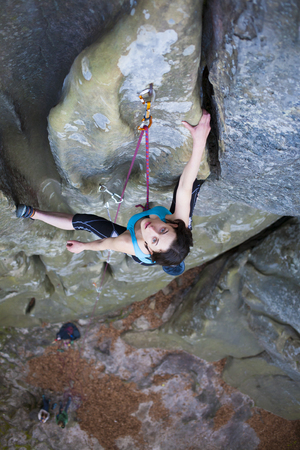1. Choosing the Right Trail for Your Group
Consider Fitness Levels and Abilities
The first step to building a successful hiking itinerary is knowing your group. Everyone’s fitness level and hiking experience matters. Are you bringing along kids, older adults, or folks new to hiking? Or is your group made up of seasoned adventurers? Matching the trail’s difficulty with your group’s abilities keeps everyone safe and ensures nobody feels left out.
| Trail Difficulty | Who Its Best For | Popular U.S. Examples |
|---|---|---|
| Easy | Families, beginners, mixed-age groups | Lower Yosemite Fall Trail (CA), Marymere Falls Trail (WA) |
| Moderate | Active adults, teens, fit beginners | Mist Trail (Yosemite, CA), Angels Landing up to Scout Lookout (UT) |
| Challenging | Experienced hikers, adventure seekers | Half Dome (CA), The Narrows (UT) |
Match Interests with Destinations
What does your group love most? Waterfalls, mountain views, forests, or wildlife? The United States has it all—from the wildflower meadows in Great Smoky Mountains National Park to the dramatic cliffs of Zion. Ask your group what excites them and pick a destination that will keep everyone engaged and inspired.
Popular U.S. Hiking Destinations by Interest
| Interest | Destination Example | Why It’s Special |
|---|---|---|
| Waterfalls | Great Smoky Mountains NP (TN/NC) | Lush trails with scenic falls like Laurel Falls Trail |
| Canyon Views | Zion National Park (UT) | Dramatic red cliffs and unique hikes like The Narrows |
| Lakes & Forests | Acadia National Park (ME) | Pine forests and lake views on Jordan Pond Path |
| Wildlife Watching | Yellowstone National Park (WY/MT/ID) | Bison, elk, geysers, and easy-access trails for all ages |
Check Park Rules and Permits Early On
Before you finalize your plans, check if the park or trail you want to visit requires permits or has special regulations. Some popular spots in the U.S., like Half Dome in Yosemite or Angels Landing in Zion, require permits due to high demand. Others may limit group size or have restrictions on pets and camping. Always visit the official park website for up-to-date info—this helps you avoid surprises and keeps your trip running smoothly.
2. Safety First: Essential Planning and Precautions
When it comes to building a hiking itinerary that everyone can enjoy, safety should always be your top priority. Whether you’re hitting the trails in the Rockies or exploring your local state park, a few smart precautions can make all the difference. Here’s what you need to know to keep your adventure fun and worry-free:
Check the Weather Forecast
Before you lace up your boots, take a moment to check the latest weather updates for your hiking area. In the U.S., weather can change quickly—especially in mountainous regions—so look for storm warnings, temperature drops, or high winds that could affect your plans. Apps like NOAA Weather or AccuWeather are popular among American hikers.
Weather Factors to Consider
| Condition | Why It Matters | What To Do |
|---|---|---|
| Thunderstorms | Lightning risk increases on exposed trails | Avoid peaks and ridgelines; reschedule if needed |
| Heat Waves | Risk of dehydration or heat stroke | Start early, bring extra water, wear sun protection |
| Snow/Ice | Slippery conditions & navigation challenges | Packed gear (microspikes), adjust route or turn back if unsafe |
| High Winds | Trees and debris can become hazards | Avoid exposed areas, stay alert for falling branches |
Share Your Hiking Itinerary
No matter where you’re headed, always let someone trustworthy know your plans. Share details like trail name, expected start and finish times, group members, and emergency contacts. In the U.S., it’s common to text this info to a friend or leave it with a park ranger when available.
Itinerary Checklist for Sharing:
- Trail name and location
- Date and time of hike
- Name and phone numbers of hikers in your group
- Estimated return time
- Vehicle description and parking spot if applicable
- Emergency contact info
Packing a First-Aid Kit: The Basics You Need
Packing a first-aid kit is non-negotiable for any hiking trip. American hikers often use small kits designed specifically for outdoor adventures—lightweight but well-stocked. Here’s a simple guide:
| Item | Purpose/Use |
|---|---|
| Bandaids & Blister Pads | Treat cuts, scrapes, blisters from boots/socks |
| Antibiotic Ointment & Alcohol Wipes | Cleansing wounds to prevent infection |
| Tweezers & Small Scissors | Remove splinters, ticks, or cut tape/gauze |
| Pain Relievers (ibuprofen/acetaminophen) | For headaches, muscle aches, minor injuries |
| Moleskin or Leuko Tape | Protect against or treat blisters on feet/hands |
| Sterile Gauze Pads & Medical Tape | Dress larger wounds |
| An EpiPen (if needed) | For severe allergic reactions (check expiry date!) |
| Sunscreen & Bug Spray | Protect against sunburn and insect bites |
| Emergency Whistle & Space Blanket | If lost or facing sudden cold/exposure |
Follow Leave No Trace Principles
The Leave No Trace (LNT) principles are part of American outdoor culture—they help keep our wild places beautiful and safe for everyone. They include things like staying on marked trails, packing out all trash, respecting wildlife, and minimizing campfire impacts. Teaching your group about LNT is a great way to ensure both fun and responsible hiking.
The Seven Leave No Trace Principles:
- Plan ahead and prepare
- Travel and camp on durable surfaces
- Dispose of waste properly (“Pack it in, pack it out”)
- Leave what you find
- Minimize campfire impact
- Respect wildlife
- Be considerate of other visitors
Taking these steps will set you up for a safe and enjoyable day on the trail—and make sure the outdoors stays awesome for future hikers too!

3. Packing for Success: Gear and Supplies
Getting your gear right is a huge part of building a safe, fun hiking itinerary in the American outdoors. Whether you’re headed to a national park or a local trail, packing smart can make or break your adventure. Here’s how to cover all the essentials so everyone in your group has what they need.
Must-Have Gear Checklist
| Item | Why You Need It |
|---|---|
| Water Bottles/Hydration System | Staying hydrated is key—bring more water than you think you’ll need, especially in hot or high-altitude areas. |
| Trail Snacks | Pack easy-to-eat foods like granola bars, jerky, trail mix, and fruit for energy along the way. |
| Layered Clothing | The weather can change quickly. Dress in layers so you can add or remove clothes as needed. |
| Sun Protection | Sunscreen, hats, sunglasses, and even SPF-rated clothing help prevent sunburns on exposed trails. |
| Navigation Tools | A map and compass or a fully charged GPS/app will help keep you on course—don’t rely only on cell service! |
| First Aid Kit | For cuts, blisters, or unexpected mishaps—a small kit can save the day. |
| Rain Gear | Ponchos or lightweight rain jackets keep everyone dry if the weather turns sour. |
| Emergency Whistle/Light | Useful for signaling if anyone gets separated from the group. |
| Trekking Poles (optional) | Add stability and reduce strain on knees during longer hikes or rough terrain. |
Packing Tips for Different Terrains and Weather
Packing for Desert Trails
- Double up on water—dehydration happens fast.
- Bring a wide-brimmed hat and light-colored long sleeves for sun protection.
Packing for Mountain Hikes
- Layer up! Mornings and evenings can get chilly even in summer.
- Packed snacks with protein help maintain energy at higher altitudes.
Packing for Forested Trails
- Bug spray is a must—mosquitoes and ticks are common.
- A small packable seat pad makes breaks more comfortable when stopping on damp ground.
Group Packing Strategy: Share the Load!
If you’re hiking with friends or family, split up shared items like first aid kits, navigation tools, and extra snacks so no one is overloaded. Make sure everyone knows who’s carrying what before you hit the trail—communication is just as important as preparation!
Quick Reminder: Leave No Trace!
No matter where you’re hiking in the U.S., always bring a trash bag to pack out everything you bring in. Respect nature so others can enjoy it too!
4. Maximizing the Fun Factor
When planning a hiking itinerary that everyone will love, adding some extra fun can make all the difference. Beyond just following the trail, bringing creative activities into your hike helps keep spirits high and makes the experience memorable for all ages and skill levels. Here are some ways to turn your next hike into an adventure packed with laughter, discovery, and excitement.
Incorporate Games on the Trail
Simple games can transform ordinary stretches of trail into playful challenges. Try these ideas:
| Game | How to Play | Best For |
|---|---|---|
| I Spy | Take turns spotting something interesting along the trail and let others guess what it is. | Kids and families |
| Scavenger Hunt | Create a list of things to find—like a pinecone, red leaf, or animal track—and see who can spot them first. | All ages |
| Name That Sound | Pause and listen; try to identify birds, insects, or rustling leaves. | Nature lovers |
| Tall Tale Time | Each person adds a line to a silly story as you walk. | Groups with creative minds |
Plan for Photo Opportunities
Catching great moments on camera is part of the adventure! Look for scenic overlooks, quirky trees, or wildflower meadows. Don’t forget group shots at summit signs or trail markers. Encourage everyone to take their own photos—these snapshots become special memories after the trip.
Top Photo Op Ideas:
- Sunrise or sunset views from open ridges
- Wildflower fields in spring or early summer
- Lakeside reflections on calm mornings
- Candid shots during snack breaks or water crossings
- Silly group poses with trail signs or unique rock formations
Add Scenic Rest Stops to Your Route
A well-timed rest stop does more than offer a break; it’s a chance to soak in the scenery and recharge. When mapping your route, mark spots known for their beauty—a creek crossing, waterfall, or panoramic overlook. These places are perfect for snacks, stretching, and sharing stories.
Rest Stop Planning Tips:
- Check maps for established viewpoints or picnic areas
- Choose spots with shade during hot months or sunny nooks in cooler weather
- If possible, pick stops near water features for added relaxation and photo ops
- Pace your hike so there’s a rest every 1–2 hours for longer treks
Look Out for Local Wildlife
Spotting wildlife is always a highlight! Bring binoculars if you have them, and look up common animals in the area before you go—whether it’s deer in the woods, eagles overhead, or salamanders near streams. Remind everyone to stay quiet when searching for animals and always observe from a safe distance.
Popular Wildlife by Region:
| Region (U.S.) | Likelier Sightings |
|---|---|
| Northeast (Appalachians) | White-tailed deer, black bear, songbirds, salamanders |
| Southeast (Smokies) | wild turkeys, foxes, butterflies, owls |
| West (Rockies & Sierra) | Mule deer, marmots, hawks, chipmunks |
| Pacific Northwest | Bald eagles, banana slugs, elk, woodpeckers |
The key to maximizing fun is mixing up activities and encouraging everyone’s participation. With games to play, beautiful stops along the way, plenty of photo ops, and local wildlife to watch out for, your hiking itinerary will be an adventure everyone remembers fondly!
5. Adapting for All Ages and Experience Levels
Pacing Your Hike for Everyone
When planning a hiking itinerary, it’s important to keep everyone’s comfort and energy in mind. Whether you’re hiking with kids, teens, adults, or seniors, setting the right pace helps make sure nobody feels left behind or pushed too hard. Take frequent breaks, especially on longer trails, and adjust your speed based on the slowest hiker. Remember, it’s not a race—it’s about enjoying the journey together.
Ensuring Accessibility on the Trail
Choose trails that match the abilities of everyone in your group. Many national and state parks across the U.S. offer accessible routes with smoother surfaces, gentle grades, and clear signage. If you have hikers with mobility challenges or young children in strollers, check trail descriptions ahead of time for accessibility features.
| Trail Feature | Best For |
|---|---|
| Paved or gravel paths | Strollers, wheelchairs, beginners |
| Mild elevation gain | Youth, families, older adults |
| Challenging terrain | Experienced hikers seeking adventure |
| Rest areas & benches | Everyone needing breaks along the way |
Making It Inclusive and Welcoming
A great hike brings people together! Encourage participation by letting everyone share what they hope to see or do—maybe spotting wildlife, taking photos, or just relaxing in nature. If you’re hiking with kids or first-timers, add fun elements like a simple scavenger hunt or story-sharing stops. Respect everyone’s pace and preferences; inclusivity means making space for all kinds of outdoor experiences.
Tips for Group Hiking Success:
- Communicate clearly about route difficulty and expectations before starting out.
- Pack snacks and water for all ages—kids and beginners may need more frequent refueling.
- If someone wants to turn back early, have a buddy system so no one hikes alone.
- Celebrate small achievements—a great view, reaching a milestone, or simply finishing together.
By balancing adventure with accessibility and inclusivity, you can build hiking itineraries that create lasting memories for everyone involved!


